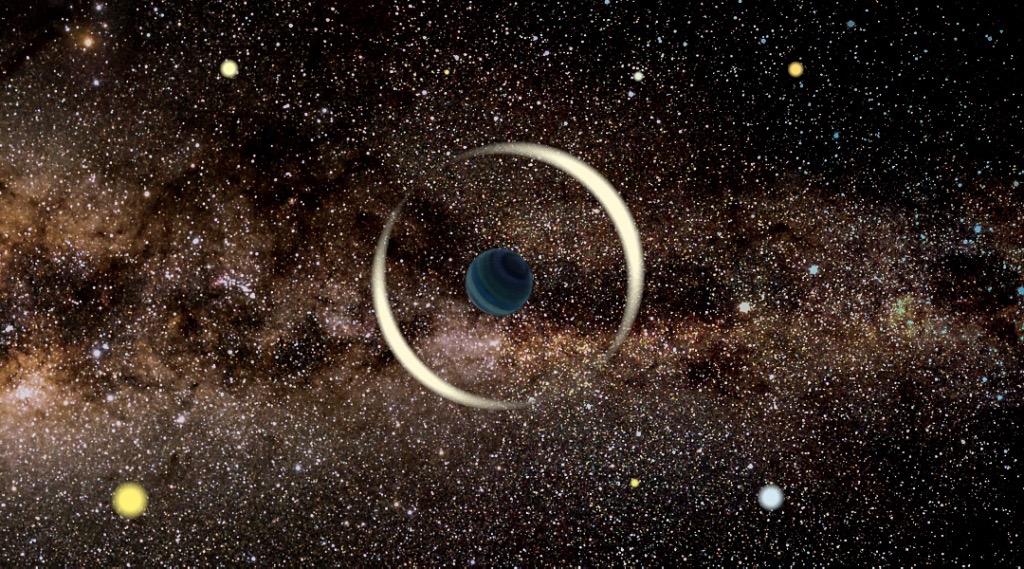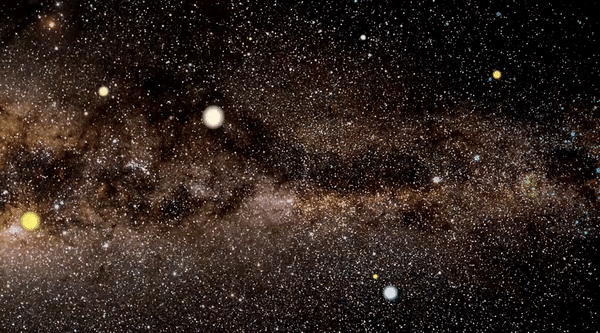
There probably aren't nearly as many giant planets zooming alone through the Milky Way galaxy as scientists had thought, a new study reports.
Previous research had suggested that huge "rogue" or "unbound" worlds, which have no discernible host star, are extremely common in the Milky Way, perhaps outnumbering stars by a factor of 2 to 1. But that's probably not the case, according to the new study.
"We found that Jupiter-mass [rogue] planets are at least 10 times less frequent than previously thought," study lead author Przemek Mróz, a researcher at the Warsaw University Observatory in Poland, told Space.com via email. [Gallery: The Strangest Alien Planets]
Astronomers think most rogue planets were likely booted out of their native solar systems by interactions with neighboring planets. Scientists generally hunt for these lonely worlds using a technique called gravitational microlensing, which involves watching for a foreground object to pass in front of a distant star. When this happens, the closer body's gravity bends and magnifies the star's light, in ways that can reveal clues about the foreground object's mass and other characteristics.
A 2011 study, based on 474 microlensing events detected by a telescope in New Zealand, estimated that gas-giant rogue worlds are nearly twice as common as main-sequence ("normal") stars in the Milky Way. (The number of stars in our galaxy is a matter of debate, with estimates ranging from 100 billion to 1 trillion.)
In the new study, Mróz and his team analyzed a much bigger data set — more than 2,600 microlensing events that were detected between 2010 and 2015 by the Optical Gravitational Lensing Experiment (OGLE). This survey, which is run by researchers at the University of Warsaw, depends primarily on observations made at the Las Campanas Observatory in Chile.
The researchers determined that the Milky Way likely hosts a maximum of one Jupiter-like rogue for every four main-sequence stars — still a lot, but to be sure, but not nearly as many as the previous study had suggested.
Get the Space.com Newsletter
Breaking space news, the latest updates on rocket launches, skywatching events and more!

The new results make sense on a number of levels, Mróz said.
"Our new microlensing observations are in agreement with theoretical expectations on the frequency of free-floating Jupiters and with infrared surveys for planetary-mass objects in star-forming regions," he said.
Intriguingly, the OGLE survey also spotted a few extremely brief microlensing events, which Mróz said were likely caused by much smaller worlds — ones about the size of Earth, or just a bit bigger.
"Because our sensitivity to such short events was very low, free-floating Earths should be very common, perhaps more frequent than stars, but we are unable to provide a precise number owing to [the] small number of detections," he told Space.com.
Increasing the number of ground-based microlensing detections would give astronomers a somewhat better understanding of the population of small rogue planets, Mróz said. But big gains may have to wait for future space observatories, such as Europe's Euclid mission and NASA's Wide-Field Infrared Survey Telescope (WFIRST).
"Thanks to the superb quality of photometry from space-based observatories and the possibility of continuous observations during approximately 100-day-long windows, future space-based missions, such as WFIRST and Euclid, will have the potential to explore the population of free-floating Earth-mass planets in more detail," Mróz and his colleagues wrote in the new study, which was published online today (July 24) in the journal Nature.
Follow Mike Wall on Twitter @michaeldwall and Google+. Follow us @Spacedotcom, Facebook or Google+. Originally published on Space.com.
Join our Space Forums to keep talking space on the latest missions, night sky and more! And if you have a news tip, correction or comment, let us know at: community@space.com.

Michael Wall is a Senior Space Writer with Space.com and joined the team in 2010. He primarily covers exoplanets, spaceflight and military space, but has been known to dabble in the space art beat. His book about the search for alien life, "Out There," was published on Nov. 13, 2018. Before becoming a science writer, Michael worked as a herpetologist and wildlife biologist. He has a Ph.D. in evolutionary biology from the University of Sydney, Australia, a bachelor's degree from the University of Arizona, and a graduate certificate in science writing from the University of California, Santa Cruz. To find out what his latest project is, you can follow Michael on Twitter.









